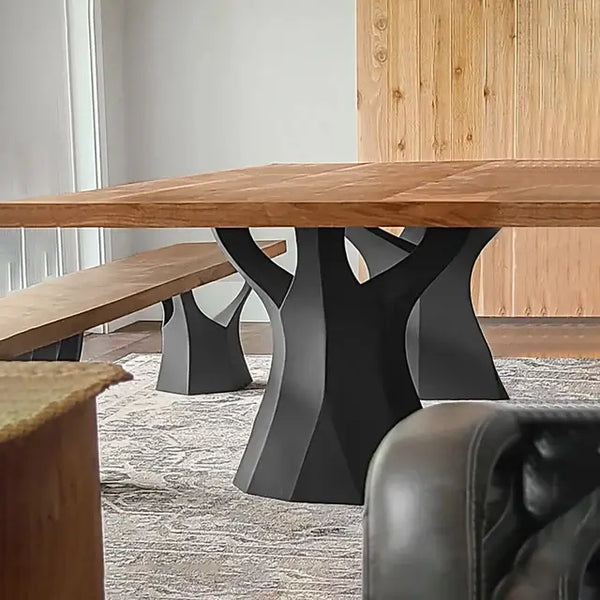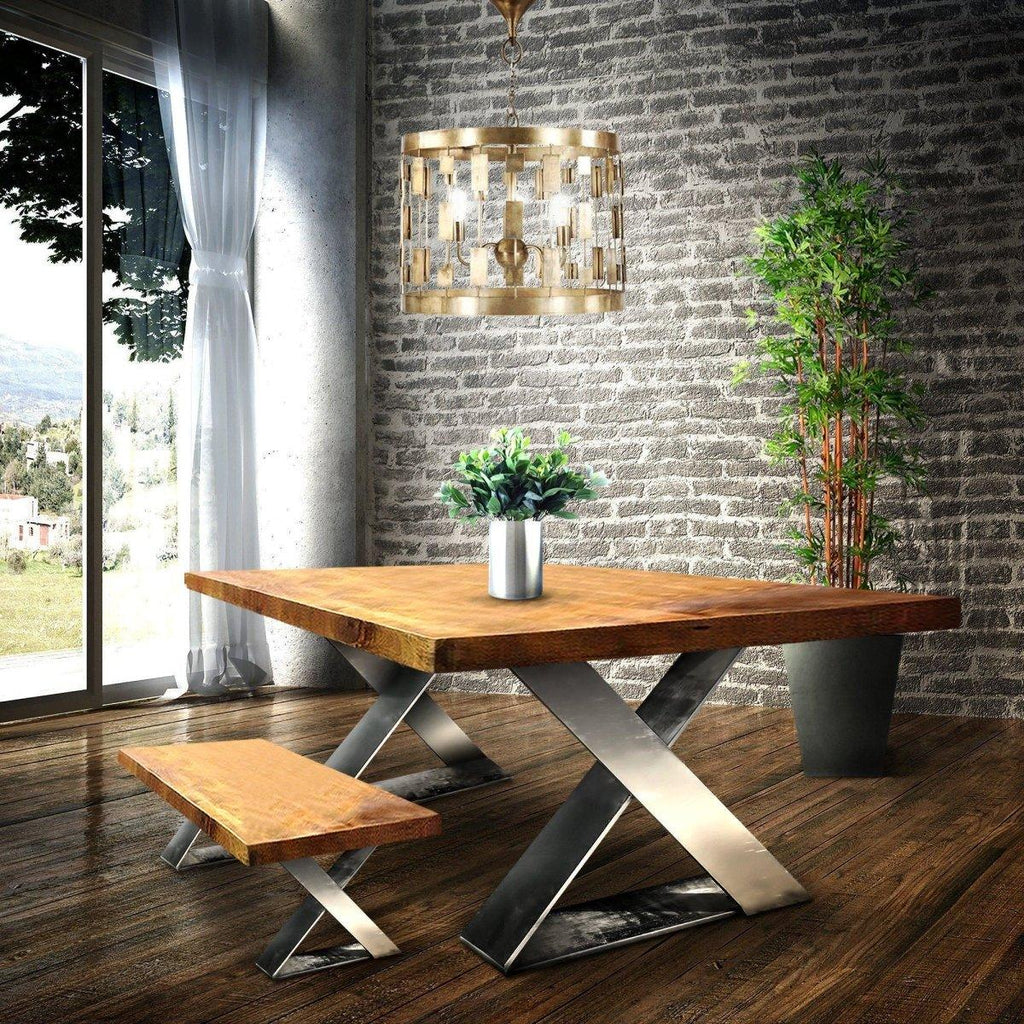Affordable and High-Quality Dining Room Table Legs for Every Budget
Affordable and High-Quality Dining Room Table Legs for Every Budget
Blog Article
From Typical to Modern: Discover the Ideal Dining-room Table Legs for Your Style
The selection of dining area table legs plays a crucial duty in specifying the overall personality of your area, connecting the space between traditional workmanship and modern-day appearances. While traditional layouts such as cabriole and transformed legs stimulate a feeling of ageless refinement, modern styles like hairpin and geometric choices provide an opportunity for striking aesthetic rate of interest. Evaluating the ideal equilibrium in between these styles calls for a nuanced understanding of your existing decor and individual preference. As you think about these aspects, the inquiry stays: exactly how can you seamlessly incorporate these varied leg styles to create a harmonious dining experience?
Recognizing Table Leg Styles
The variety of dining area table leg designs can significantly affect both the aesthetic appeals and capability of the space. Each leg design contributes one-of-a-kind practical features and aesthetic aspects, dealing with diverse design preferences and use requirements. Understanding these styles is essential for picking the best table that straightens with your overall interior decoration vision.
For example, conical legs provide a tidy, traditional appearance that can improve a space's style, while pedestal bases supply security and take full advantage of legroom, making them suitable for smaller rooms. Hairpin legs, a hallmark of mid-century contemporary design, present a commercial style, permitting an airy, open feel. Trestle legs stimulate rustic appeal, providing durable assistance and a feeling of eternity.
Wood legs can bring heat and appearance, whereas metal alternatives usually convey a streamlined, modern ambiance. Eventually, recognizing table leg designs is important for developing a cohesive dining area that reflects personal style while making certain practicality and convenience.
Standard Table Leg Options
When selecting dining-room table legs, conventional choices commonly symbolize classic beauty and workmanship. These layouts reflect an abundant heritage and a commitment to quality, making them suitable for those who value traditional visual appeals.
One of one of the most iconic standard leg styles is the cabriole leg, characterized by its elegant curved form. This layout frequently features decorative makings and is most typically located in Queen Anne and Chippendale furniture. An additional preferred choice is the turned leg, which flaunts a collection of smooth, rounded shapes that supply a traditional look while preserving security.
Moreover, the straight leg, while easy, uses a basic and durable structure that can blend flawlessly with a variety of tabletop styles. For those drawn to ornate describing, claw-and-ball feet legs stimulate a sense of majesty and can work as a sensational focal point in any dining area.
Last but not least, pedestal bases, although not purely legs, offer an alternate conventional choice that permits enough legroom and can be beautifully sculpted. Each of these typical leg designs contributes to find out the general atmosphere of a dining space, marrying function with aesthetic allure.

Modern Table Leg Styles
Modern table leg designs use a diverse variety of styles that highlight tidy lines and innovative products. These layouts typically focus on capability while functioning as striking focal factors within a dining room. Minimal appearances are prevalent, with legs crafted from materials such as metal, glass, and engineered timber, which add to a modern and ventilated feel.
One prominent design is the hairpin leg, identified by its slender, tapered structure that supplies security without overwhelming the tabletop (dining room table legs). This style is often located in mid-century modern furnishings and can effortlessly enhance various eating table forms. Another trend is using geometric shapes, where legs may tackle unbalanced or that site angular kinds, adding visual rate of interest and a touch of creativity

Mixing Styles for Special Areas
Often, homeowners seek to produce unique dining spaces that mirror their personal style by mixing different layout elements. This method enables the unification of diverse aesthetic go to the website appeals, leading to a harmonious yet distinct atmosphere. For circumstances, coupling a rustic wooden table with smooth, modern-day steel legs can develop an appealing comparison that elevates the room's total allure.
In addition, integrating vintage table legs with modern table tops can evoke a sense of history while maintaining a modern perceptiveness. Such mixes not just showcase individual preference but also motivate creativity, allowing house owners to curate a space that really feels both personal and inviting.
Shade plays a vital role in this mixing procedure; selecting table legs that match or contrast with the existing shade plan can improve aesthetic passion. Whitewashed legs can soften the boldness of a dark table surface area, producing a well balanced visual.
Tips for Choosing the Right Legs
Picking the right table legs is essential for attaining both performance and aesthetic charm in your eating space. Begin by considering the general design of your room. Standard setups benefit from legs that feature elaborate makings or transformed designs, while contemporary areas might ask for streamlined, minimal designs.
Following, assess the height and security of the legs. dining room table legs. Standard dining tables range between 28 to 30 inches in elevation, so make certain the legs complement this measurement for comfort. Furthermore, durable products, such as hardwood or steel, can enhance stability and durability
Examine the leg form too-- alternatives consist of straight, tapered, or pedestal designs. Straight legs provide a timeless look, while conical legs can include a touch of elegance. Pedestal bases supply sufficient legroom and are perfect for smaller spaces.
Final Thought
In recap, choosing the suitable dining-room table legs calls for mindful factor to consider of both modern and conventional styles. Conventional choices such as cabriole and transformed legs provide timeless elegance, while modern-day designs like hairpin and geometric shapes give a contemporary touch. By harmonizing leg design, height, and material with the overall decoration, a natural and inviting ambience can be attained. Inevitably, the selected table legs need to reflect the desired visual, boosting the dining experience within the area.
The selection of eating area table leg designs can substantially affect both the visual appeals and performance of the room. Eventually, understanding table leg styles is important for creating a cohesive eating location that reflects individual style while guaranteeing functionality and convenience.One of the most legendary typical leg styles is the cabriole leg, characterized by its graceful bent form. Straight legs offer a traditional appearance, while tapered legs can add a touch of sophistication.In recap, picking the suitable eating space table legs requires mindful consideration of both modern-day and typical styles.
Report this page